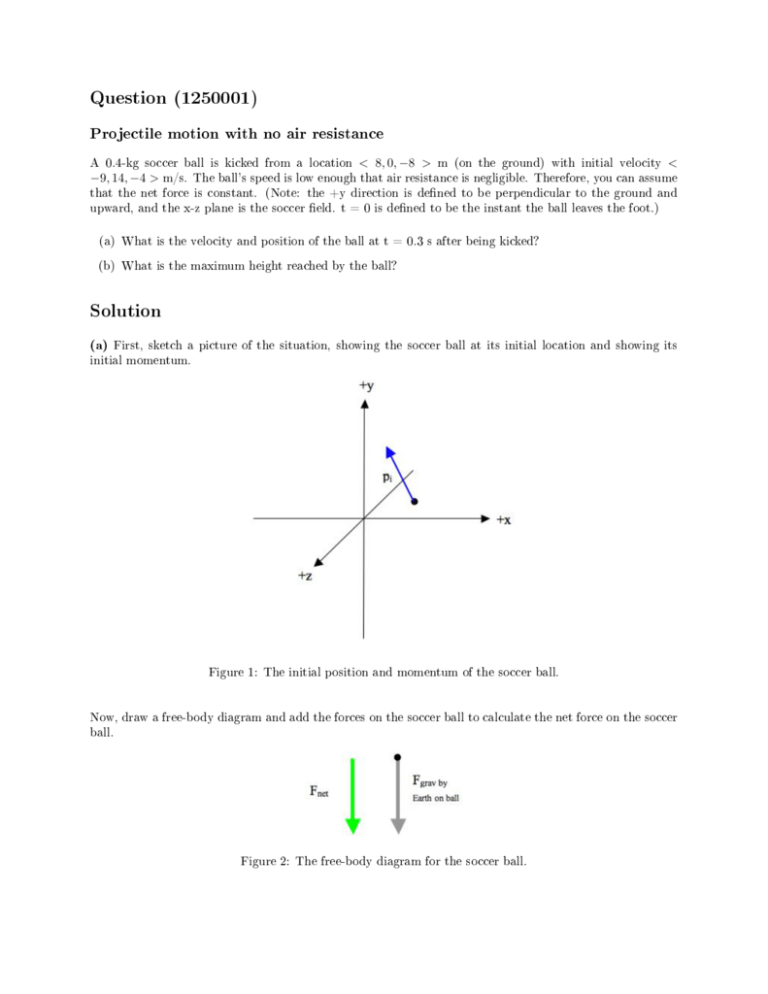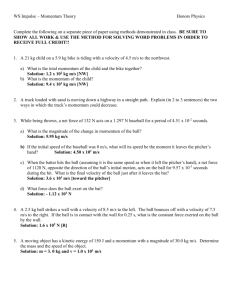pdf file
advertisement

Question (1250001) Projectile motion with no air resistance A 0.4-kg soccer ball is kicked from a location < 8, 0, −8 > m (on the ground) with initial velocity < −9, 14, −4 > m/s. The ball's speed is low enough that air resistance is negligible. Therefore, you can assume that the net force is constant. (Note: the +y direction is dened to be perpendicular to the ground and upward, and the x-z plane is the soccer eld. t = 0 is dened to be the instant the ball leaves the foot.) (a) What is the velocity and position of the ball at t = 0.3 s after being kicked? (b) What is the maximum height reached by the ball? Solution (a) First, sketch a picture of the situation, showing the soccer ball at its initial location and showing its initial momentum. Figure 1: The initial position and momentum of the soccer ball. Now, draw a free-body diagram and add the forces on the soccer ball to calculate the net force on the soccer ball. Figure 2: The free-body diagram for the soccer ball. This case is easy because there is only one force acting on the soccer ball after it's kicked, and it's the gravitational force by Earth on the soccer ball. Thus, F~net = F~grav by Earth on ball = (0.4 kg)(< 0, −9.8, 0 > N/kg) = < 0, −3.92, 0 > N To predict the momentum, apply the momentum principle. ∆~ p = F~net ∆t p~f − p~i = F~net ∆t p~f = p~i + F~net ∆t = (0.4 kg)(< −9, 14, −4 > m/s) + (< 0, −3.92, 0 > N)(0.3 s) = (< −3.6, 5.6, −1.6 > kg m/s) + (< 0, −1.176, 0 > Ns = < −3.6, 4.424, −1.6 > kg m/s Use the nal momentum to calculate the nal velocity at t = 0.3 s. p~f ~vf ≈ m~vf p~f = m < −3.6, 4.424, −1.6 > kg m/s = 0.4 kg = < −9, 11.06, −4 > m/s Note that the y-velocity decreased since the net force is in the downward direction. The x-velocity and z-velocity remained constant because there is no force in the x or z direction to change the x or z velocity. To calculate the position of the ball at t = 0.3 s, we'll need its average velocity. ~vavg ~vf + ~vi 2 < −9, 11.06, −4 > m/s+ < −9, 14, −4 > m/s = 2 < −18, 24.06, −8 > m/s = 2 = < −9, 12.03, −4 > m/s = Apply the denition of average velocity to calculate the nal position at t = 0.3 s. ~vavg ~rf ∆~r ∆t ~rf − ~ri = ∆t = ~ri + ~vavg ∆t = = < 8, 0, −8 > m + (< −9, 12.03, −4 > m/s)(0.3 s) = < 8, 0, −8 > m + (< −2.7, 3.61, −1.2 > m) = < 5.3, 3.61, −9.2 > m The displacement of the soccer ball between t=0 and t=0.3 s is < −2.7, 3.61, −1.2 > m. Thus, the ball traveled left (x direction), upward (+y direction), and backward (z direction) on our coordinate system. Figure 3: The position and momentum of the soccer ball at t=0 and t = 0.3 s. (b) To nd the maximum height reached by the ball, we will dene the nal position to be the ball's peak. At this position, the y-velocity of the ball is zero. Thus, at the peak, the nal velocity is ~vf = < −9, 0, −4 > m/s and the nal momentum is p~f = m~vf = (0.4 kg)(< −9, 0, −4 > m/s) = < −3.6, 0, −1.6 > kg m/s Use the Momentum Principle to nd the time when this occurs. Since the net force is only in the y-direction, write the momentum principle in component form and use the y-component only. ∆~ p = F~net ∆t ∆py = Fnet,y ∆t ∆py ∆t = Fnet,y pf,y − pi,y ∆t = Fnet,y 0 − (0.4 kg)(14 m/s) = −3.92 N −5.6 kg m/s = −3.92 N = 1.43 s With the time for the peak known, then its position can be calculated. Once again, you have to rst calculate the average velocity between when the ball is kicked and when it reaches its maximum height. ~vavg ~vf + ~vi 2 < −9, 0, −4 > m/s+ < −9, 14, −4 > m/s = 2 = < −9, 7, −4 > m/s = Now use the update form of the denition of average velocity to calculate the position at t = 1.43 s. ~rf = ~ri + ~vavg ∆t = < 8, 0, −8 > m + (< −9, 7, −4 > m/s)(1.43 s) = < 8, 0, −8 > m+ < −12.87, 10, −5.72 > m = < −4.87, 10, −13.72 > m At its peak, the ball is 10 m from the ground. That is more than 30 ft, so it's about as high as a 3-story building from ground level. That's quite a kick! Here's a sketch of the ball at its peak. Note that the ball's momentum at the peak is parallel to the x-z plane and has both an x and a z component. This is not necessarily evident in the picture, however. Figure 4: The position and momentum of the soccer ball at its peak (t=1.43 s).









